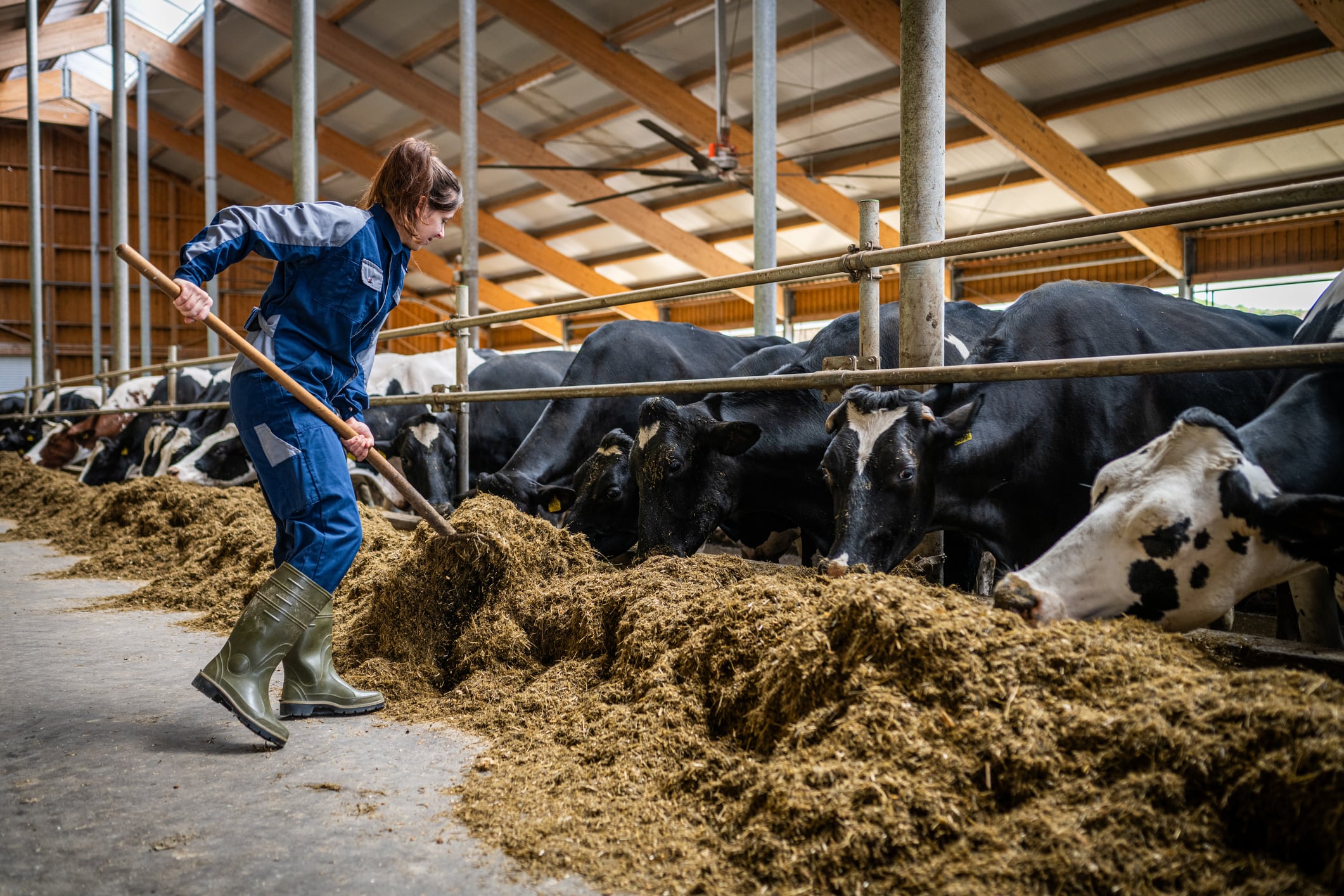With US president Trump set to unleash immigration raids nationwide, how can agriculture businesses prepare to face ICE agents and ensure their employment authorization paperwork is in check?
The Center of Dairy Excellence recently hosted a webinar on the matter, with Brook Duer – an experienced staff attorney at the Center for Agricultural and Shale Law at Penn State Law and former chief counsel at the US Department of Agriculture – explaining some of the key concepts and strategies that ag employers need to know to overcome a potentially major business disruption.
Immigrant workers are essential in the US dairy industry, where they make up just over half (51%) of labor. Of those, between 46-70% are undocumented, according to a 2023 University of Wisconsin-Madison School of Workers study (see ‘sources’ below for more information). Research has shown that removing immigrant labor completely would shrink the US dairy herd by more than two million cows and hike milk prices by more than 90%.
Elsewhere, the USDA ERS estimates that around half of crop farmworkers are undocumented.
And yet, US policymakers have resisted calls to prescribe legal rights to these workers by setting up a year-round visa program - a solution that trade bodies including the National Milk Producers Federation have lobbied for over the years.
With ICE raids already hitting agricultural operations, Duer laid out some of the ground rules of getting through such enforcement event or dealing with the more common of the two occurrences: being served a L-9 audit notification.
Dealing with L-9 notices
In a nutshell, an L-9 audit is when the USCIS asks to look at your L-9 forms and all of your files that hold the L-9 forms, Duer explained.
“You have three business days to produce any documents in an L-9 audit. You don’t have to provide these immediately, on the spot. The officers may show up unannounced and hand-deliver a written notice of inspection, but you still have three days [to comply with their request].
“Never waive the three-day notice for producing documents – you want to make sure your documents are in order, consult with an attorney, and ensure you’ve done everything to respond to the request.”
Brook Duer
A formal notice of inspection will spell out what the employer would need to supply, be it L-9 forms or other documentation, such as payslips or time sheets.
“They want to match up the dates and periods of time someone worked for you with those covered by the L-9 forms,” Duer explained. “This can sometimes take a series of back and forth – they may just ask for L-9 forms initially, then follow up with other things relating to specific employment records.”
Employers may face civil fines and even criminal prosecution if found to have knowingly violated the law. As for workers found to be in the US illegally, they face arrest and deportation.
ICE at the door? Stay calm
Who's ICE?
Standing for Immigration and Customs Enforcement, this is the enforcement division of the Unites States Citizenship and Immigration Service (USCIS), itself part of the Department of Homeland Security.
ICE agents have broad powers, including to arrest, detain or deport people who don’t have legal right to work in the US, as well as execute warrants, conduct searches and carry out seizures related to an immigration enforcement investigation.
In short, an ICE raid is the execution of a search warrant for one reason or another – for example, if the US immigration service has information about a specific employee that is related to a criminal case.
“This is where it gets difficult for an employer,” Duer warned - adding that it’s essential for business owners to know how to respond to agents if they turn up at their door unannounced.
“You don’t have to let them on the property to look for somebody if they don’t have a warrant,” Duer said.
“And when they are looking for person A but things start to go a little farther than that, that’s when you say, again, that they need a warrant for that.”
“You need to rehearse your rights as a property owner – that is going to protect your entire operation from any unanticipated occurrences. It’s a speech you have to get comfortable at making."
Is there a way to anticipate an ICE raid? Not really, Duer said.
“There isn’t any centralized database on what is going on in a way that you could maybe pick up some trends; see that ICE is very active in Missouri or South Dakota, for example. There’s nothing like that out there.
“Everything we are hearing at this point in time about what’s happening in the field is anecdotal.”
L-9 audits skyrocket under Trump
According to international legal practice Littler Global, during the first Trump administration (2016-2020), ICE enforcement of L-9 compliance was at a record-high. L-9 audits increased to 5,981 in FY2018 and 6,450 in FY2019; and the aim was to reach 12,000 to 15,000 audits in FY2020, a target curtailed by the pandemic. The aim was to create 'a culture of compliance among employers' according to Derek Benner, the then Acting Executive Associate Director for Homeland Security Investigations, the predecessor to USCIS.
In comparison, the Obama administration averaged 3,500 audits a year.
He added that USCIS publishes some public information on enforcement action – typically when it’s linked to specific arrests that are connected with federal government action, such as a multi-state criminal case - but not on routine action.
“They are not releasing press releases every time something occurs, which they are not required to,” Duer said.
Five ways to prepare for and survive a raid
The Penn State Law counsel highlighted several key steps to get through an enforcement event, whether an audit of L-9 forms or a full-on raid at the farm.
- Hire an attorney
“This wouldn’t be routine practice for most people, but is fundamental to this because you only have three days to get things together [to supply l-9-related paperwork] – and you want to make sure you’re doing it right.”
- Name a designated person to deal with ICE agents
Ag businesses should establish a protocol detailing what goes on if they get a notice of inspection (NOI), Duer added - including who deals with enforcement agents.
“You should have people whose roles on your payroll are already established in terms of what they are going to do – who’s going to handle the auditors directly.
“That person should be well-rehearsed at doing that. They could just be documenting what ICE agents are doing, getting their badge numbers and names, and so on.”
- Inform workers
How a business notifies its employees of an impending or ongoing enforcement event is also key, he added.
“You want to have a protocol for notifying all your employees – the ones that are on the premises at the time as well as those who aren’t on shift - so they can understand what’s going on and what is expected of them."
- Get workers in one place - and control the conversation
In addition to notifying workers, the employer should also ensure they are not getting in the way of an ongoing ICE investigation.
“You don’t want your employees walking around the work site while these agents are there – it’s better to elect someone to instruct them to report to a particular building, for example.”
“It’s just as important to have your employees in a certain place until this event is over, as it is to cooperate with the agents.”
And: “No employee should ever be having casual conversation or volunteering any information or access to documents to the agents who show up to do an L-9 audit,” Duer added. “That needs to be a very controlled conversation where they talk to one person – say, the designated person recording what’s going on – but not a crowd."
- Signpost your property
Knowing what to say to agents is one thing – but making sure they can’t access private parts of the property due to assuming access is public would be crucial to avoiding disruption.
“Start thinking about marking your property through signage as to what’s open to the public and what isn’t,“ Duer said. ”You can’t overdo this.
“Having your workplace clearly marked with the areas that are open to the public and those that are not is one of the most important [ways to ensure] that when the agents show up, it’s clear they are not to go beyond this point.”
Sources:
Dairy Workers Study: Legal and Community Needs Assessment; Authors: Armando Ibarra et al. Accessed 06/11/2025. https://schoolforworkers.wisc.edu/wp-content/uploads/sites/795/2023/06/Dairy-Workers-Study-Legal-and-Community-Needs-Assessment.pdf


